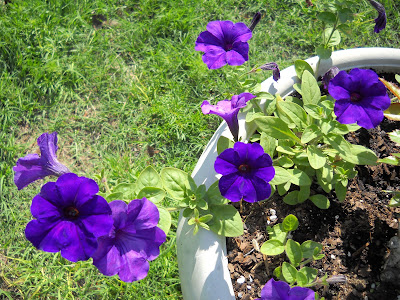I got up this morning (on my birthday) and walked around the house with my camera. Then I took a photo of every bloom that I was able to find, to capture beauties for my very own birthday flower bouquet - that will last for ever.
Here's a quick tour of the April blossoms from my yard... :)
Photo above: Red Dianthus (smells beautiful!) and blue Petunias. Stunning combination and it took me quite a few shots to get the colors right. As the petunias produce more and more blooms, the contrast will become even more eye-catching.
Photo above: Blue wildflowers that sprouted this spring in our front yard without an invitation. I plan on pulling them out as soon as they stop blooming but at the moment they look very nice, I like seeing them every day and taking photos of them was fun. Have no idea what they are called, though.
Photo above: Blue/purple petunias used as a companion plant to orange/peach tea rose. The combination of flower colors and foliage is striking.
Photo above: White-edged petunias blooms look like they are floating in the air and have no stems. They make me smile every time I see them... :)
An important update: Last night we had quite a storm with high winds and pouring rain - and it lasted for hours. While some of my petunias' blooms look battered, this white-edged petunia looks as cheerful and beautiful as always!
Photo above: Blue/purple petunias open up in really dark, royal blue color and then slowly fade to almost lavender tone. When sunlit, red hues are noticeable and every flower looks like unique piece of art.
Photo above: Peace lily can be an indoor or outdoor plant in Florida. As houseplants, they have an admiring reputation as one of the
best indoor air cleaning plants.
Photo above: Blooming onion chives, an herb I never run out of. This past winter when we had record low temperatures, chives didn't mind them one bit. It stayed green and cheerful and kept growing throughout the cold season. My chives do best in the large planter next to the tea rose.
Photo above: One of the plants I most care about - red rose Barbra Streisand, birthday gift from my mom a few years back. It doesn't bloom too much so every bud brings happy expectation and I keep checking every day to when the bloom will open. At the moment it has three buds and that has not happened ever before... :)
Photo above: My red Amaryllis started blooming on my birthday and I very much enjoy these large, graceful, colorful blooms and every year take quite a few pictures since they don't last very long in our Florida heat.
So this is my birthday bouquet. There are actually more blooming plants around my house but not all of the photos were good enough for publishing. Certain colors just don't come out right when the sun is too bright and since I am not a professional photographer, I depend on some luck with my shots... :)
***












